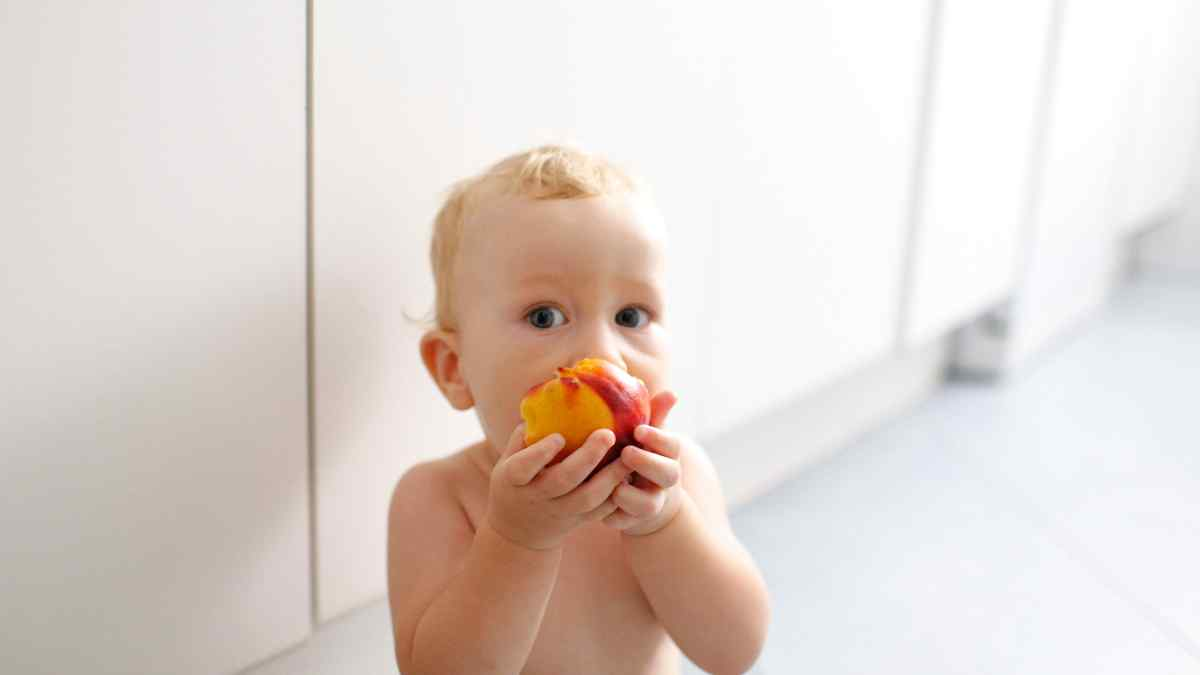Every parent anticipates and sometimes even dreads that moment when their infant takes the monumental step from a liquid diet to the vibrant world of solid foods. This transition is more than just a rite of passage; it’s an integral phase in a child’s growth, laying the foundation for healthy eating habits that will last a lifetime.
As babies explore flavors, textures, and the very act of eating, caregivers face myriad questions. When should you introduce solids? Which foods are best to start with? How do you ensure proper hydration? It’s easy to feel overwhelmed. With this guide, we aim to offer clear, evidence-based insights and support as you embark on this exciting journey of introducing your child to the wonderful world of food and the importance of hydration.

Signs That Your Baby is Ready for Solid Foods
Every parent eagerly awaits that moment when their little one transitions from the familiar territory of breast milk or formula to the realm of baby solid foods. This journey from bottle feeding to eating solid foods is one that requires patience and keen observation. Most babies are primed to start solid foods between four to six months of age, but the timeline isn’t universal. It’s essential to watch for particular signs that your baby is ready, ensuring a smooth transition to new food textures and items.
1. Good Head Control and Sitting without Support
Before introducing solid foods, your baby needs to have good head control. This isn’t just about neck strength; it’s about ensuring they can safely swallow without choking. Also, sitting without aid, perhaps in a high chair, shows that the baby’s growth and development are on track for this new dietary adventure.
2. Curiosity about Your Food
Ever noticed your little one’s eyes tracking your fork from plate to mouth or reaching out for a piece of fruit you’re munching on? This heightened interest indicates they’re ready to expand beyond breastmilk or formula. Healthy babies are naturally curious, so if they’re eyeing up those mashed foods or cooked vegetables on your plate, it may be time to introduce them to baby food.
3. Open-Mouthed Anticipation
When you offer a spoon and your infant eagerly opens up, it’s a pretty clear sign. Most babies who are ready for solid food will show enthusiasm. Remember, introducing foods goes beyond nutrition; it’s about instilling good eating habits early on.
4. Overcoming the Tongue-Thrust Reflex
This reflex, which makes younger babies push food out of their mouths, reduces as they grow. When your baby starts accepting food, moving it from the spoon into their throat without pushing it out, it indicates that their baby’s digestive system and motor skills are maturing.
Now, as parents embrace this new chapter of feeding their baby, there are also cautionary notes to consider:
- Allergenic Foods: While it’s essential to offer a variety of foods, parents should be aware of allergenic foods, especially if there’s a family history. Introducing items like nut butters should be approached with caution, keeping an eye out for any allergic reaction.
- Choking Hazards: Foods like whole nuts, hot dogs, and raw vegetables can be dangerous. Ensure that foods like well-cooked pasta or ripe banana are mashed or cut into manageable, bite-sized pieces.
- Introduce One at a Time: To monitor potential food allergies, introduce one new food every few days. This way, if there’s an allergic reaction, it’s easier to pinpoint the cause.
- Stay Nutritious: While it might be tempting to introduce cow’s milk early on or to give fruit juice for its sweet allure, remember to prioritize iron-rich foods, pureed meats, and veggies. Introducing solids should be about diversifying your baby’s diet while ensuring healthy growth.

First Foods to Introduce Your Baby to Solid
Having discerned the signs that your baby is ready for solids – from their improved posture in holding their head up and sitting without support, to their unmistakable interest in the foods you’re eating – the subsequent thrilling chapter is deciding which first foods to introduce. Pioneering into the world of solid foods is a crucial milestone for both parents and baby. But with a myriad of options and dietary guidelines, where should you begin?
Single-Grain Cereals
Starting solid foods often begins with single-grain cereals, and for good reason. Foods like rice cereal are gentle on a baby’s developing digestive system and provide essential nutrients. Oatmeal and barley are other commendable choices. These cereals can be effortlessly mixed with breast milk or formula, providing a familiar taste for your baby as they navigate the texture of solid food.
Pureed Fruits
Fruits are nature’s candy, and for a baby experiencing flavors for the first time, pureed apples, pears, and bananas are delightful introductions. They’re not just sweet and palatable but also packed with essential vitamins. Always ensure the fruits are thoroughly pureed to a smooth consistency, reducing any risk of choking.
Pureed Vegetables
While fruits are a great hit, introducing solids should be a balanced affair. Vegetables such as sweet potatoes, carrots, and cooked peas are nutrient-dense options. Sweet potato, for instance, is a powerhouse of Vitamin A, while peas bring in a good dose of proteins. Again, the smoother the puree, the easier it is for your baby to adjust to eating solids.
Organic and Non-GMO Recommendations
As parents, the health and well-being of your baby are paramount. Therefore, when selecting baby foods, especially when you’re making your own baby food, opt for organic and non-GMO options. While some might argue about the cost differential, investing in organic produce reduces the intake of processed foods laden with pesticides and potential allergens. Moreover, many believe that organic foods taste better, making the experience more enjoyable for the baby.
A word of caution as you introduce foods: always monitor for signs of food allergies. If your baby develops a rash, experiences excessive weight gain or loss, or shows any signs of discomfort after eating, consult your pediatrician.

Techniques for Introducing New Foods
Embarking on the journey of introducing solid foods to your baby, you’ve acquainted them with foundational items: single-grain cereals like rice and oatmeal, the delightful sweetness of pureed fruits such as apples and bananas, and the nutritious punch of pureed veggies including sweet potatoes and carrots. Armed with knowledge about organic and non-GMO options, you’re prioritizing the best for your baby’s health. Yet, as your baby’s palate starts to evolve, the pathway to diversifying their diet warrants special techniques. Here’s how to seamlessly introduce new foods to ensure the journey of feeding your baby remains delightful and stress-free.
1. Start Small
When you introduce solid foods, especially a new item, always start with a small amount. This not only helps your baby adjust to the new taste gradually but also ensures they don’t feel overwhelmed. Think of it as offering a sample of a new dish, allowing your baby to explore and decide if it pleases their budding taste buds.
2. Monitor for Allergies
While your baby might relish the pureed pears or cottage cheese, it’s crucial to wait several days before introducing another new food. This gap is essential to monitor any signs of a food allergy. Symptoms could range from mild (like a small rash) to more severe reactions. Being observant during these intervals ensures you can easily pinpoint any food that doesn’t agree with your baby’s system.
3. Blend with the Familiar
A smart hack to ensure a smoother transition as you start solid foods is to mix new foods with breast milk or infant formula. This familiarizes the baby with the taste, making the new ingredient less daunting. For instance, if you’re introducing spinach, a mix of spinach puree with breast milk can make the experience less jarring for the baby. It’s about blending the unknown with the known, catering to the baby’s appetite in a nurturing manner.
4. Diverse Textures and Tastes
As months of age go by, your baby’s first food experiences should expand in texture and taste. The transition from pureed foods to finger foods, for example, should be gradual. While initially, silky smooth purees might be the go-to, over time, introducing chunkier textures or even soft finger foods can be beneficial. This not only acclimates the baby to different food textures but also preps them for future eating habits.
Foods to Avoid in the First Year
As you pave the way for your little one’s culinary journey, introducing them to an array of solid foods, textures, and flavors, there’s an exhilarating sense of discovery at every mealtime. Having equipped yourself with the techniques of offering new foods in small amounts, waiting intervals between new introductions, and mixing in breast milk or infant formula for familiarity, you’re on a path to fostering healthy eating habits. However, amidst the excitement, it’s crucial to be aware of certain foods that should be approached with caution or avoided entirely during the baby’s first year. Here’s a guide to ensure safe feeding for your baby.
1. Honey
Sweet as it may be, honey is a no-go for infants under 12 months of age. The reason? It poses a risk of botulism, a rare but serious illness caused by toxins that could be present in honey. While adults and older children’s digestive systems can handle these toxins, an infant’s system isn’t mature enough, making it a risky addition to baby food.
2. Cow’s Milk as a Primary Drink
While dairy can be introduced as part of meals, cow’s milk shouldn’t replace breast milk or infant formula as the primary drink in the first year. The reason is twofold: Firstly, cow’s milk can interfere with iron absorption, which is essential for your baby’s growth. Secondly, it lacks the optimal nutrients that breast milk or infant formula provide for your growing baby.
3. Choking Hazards
As eager as you might be to see your baby eat solid foods, some items are outright dangerous. Nuts, whole grapes, popcorn, hard candies, and the like pose significant choking risks. Even as you start introducing solid foods and textures, ensure everything is age-appropriate, mashed, or cut into baby-safe sizes. Vigilance during meal times is indispensable.
4. Highly Allergenic Foods
While it’s essential to offer a variety of foods, some are known allergens. Traditionally, parents were advised to delay introducing items like eggs due to the potential egg allergy risk. However, recent studies suggest early and gradual introduction might help reduce allergy risks. It’s crucial to consult with your pediatrician about the best strategy for your baby. When introducing any potential allergen, start with a tiny amount, monitor closely for any reactions, and ensure it’s done at a time when you can watch your baby for several hours afterward.

Conclusion
The realm of baby food is a fascinating mix of tastes, textures, and vital nutrients essential for growth and development. As your baby progresses from the simplicity of breast milk or formula to the multifaceted world of solids, it’s a journey filled with delightful discoveries, essential learnings, and moments that will form the cornerstone of their lifelong relationship with food.
Remember, each baby is unique. While general guidelines provide a roadmap, paying close attention to your baby’s cues, preferences, and reactions is paramount. There might be days when they show an aversion to certain foods, only to relish them weeks later. Or moments when they seem more interested in playing with their food rather than eating. It’s all part of the process.
The first year of a baby’s life is filled with numerous milestones, and introducing solid foods is undeniably a standout. Relish every moment, capture those messy meal times, and cherish the shared experiences at the dining table. Before you know it, your little one will be making food choices on their own, underpinned by the foundations you laid during this pivotal first year. Here’s to happy, healthy eating and a lifetime of culinary joy for your baby!
Did this article help you? If so, please let us know! If you have any questions, don’t hesitate to ask.



